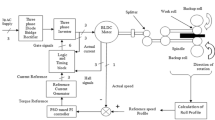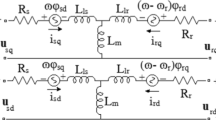Abstract
Under the operation of brushless DC motor with three-phase excitation, commutation current pulsation is produced at each commutation at high-speed region. As it can be eliminated when the current slew rates are made equal, a simple and effective fuzzy logic estimator (FLE) is presented first time in the literature to reduce such current pulsation. Its function is to simply regulate the commutation angle accurately to maintain the same current slew rates of commutated phases during commutation, thereby keeping the other phase current unchanged. Unlike previous studies, the presented method does not require torque observer or detection circuits for sensing commutation interval, in addition to commutation time calculation. A genetic algorithm is employed for optimal definition of the FLE’s rule base. The presented method is tested by the accurate simulation, and it is proved that the proposed method is quite capable of reducing the commutation current pulsation and improving the motor output power.











Similar content being viewed by others
References
Singh B, Bist V (2013) Improved power quality bridgeless ćuk converter fed brushless DC motor drive for air conditioning system. IET Power Electron 6:902–913
Pan CT, Fang E (2008) A phase-locked-loop-assisted internal model adjustable-speed controller for BLDC motors. IEEE Trans Ind Electron 55:3415–3425
Saygın A, Cemil O, Dalcalı A, Çelik E (2015) Optimum rotor design of small PM BLDC motor based on high efficiency criteria. ARPN J Eng Appl Sci 10:9127–9132
Xiu J, Wang S, Xiu Y (2013) Fuzzy adaptive single neuron NN control of brushless DC motor. Neural Comput Appl 22:607–613
Shi J, Li TC (2013) New method to eliminate commutation torque ripple of brushless dc motor with minimum commutation time. IEEE Trans Ind Electron 60:2139–2146
Meng G, Xiong H, Li H (2009) Commutation torque ripple reduction in BLDC motor using PWM_ON_PWM mode. In: IEEE electrical machines and systems conference, pp 1–6
Lin YK, Lai YS (2011) Pulsewidth modulation technique for BLDCM drives to reduce commutation torque ripple without calculation of commutation time. IEEE Trans Ind Appl 47:1786–1793
Nam KY, Lee WT, Lee CM, Hong JP (2006) Reducing torque ripple of brushless DC motor by varying input voltage. IEEE Trans Magn 42:1307–1310
Zhang XF, Hu QB, Lu ZY (2005) Torque ripple reduction in brushless DC motor drives using a buck converter. Trans China Electrotech Soc 20:72–81
Shi T, Guo Y, Song P, Xia C (2010) A new approach of minimizing commutation torque ripple for brushless DC motor based on DC–DC converter. IEEE Trans Ind Electron 57:3483–3490
Kim I, Nakazawa N, Kim S, Park C (2010) Compensation of torque ripple in high performance BLDC motor drives. Control Eng Pract 18:1166–1172
Shi X, Chang S (2011) Commutation force ripple reduction in a novel linear brushless DC actuator based on predictive current control. Electr Power Compon Syst 39:1609–1620
Hui H, Weidong J, Yongsheng W, Lei W (2016) Commutation analysis and reducing torque ripple of brushless DC motor based on the coordination transformation. In: IEEE 8th international power electronics and motion control conference, pp 2538–2544
Shanthamoorthy V, Jothi swaroopan NM (2014) Design of intelligent controller to reduce the torque ripple in a brushless DC motor drive. Int J Adv Res Electr Electron Instr Eng 3:467–476
Yaya S, Honghua W (2009) Research on reduction of commutation torque ripple in brushless DC motor drives based on fuzzy logic control. In: IEEE 2009 computational intelligence and security conference, pp 240–243
Öztürk N, Çelik E (2012) Speed control of permanent magnet synchronous motors using fuzzy controller based on genetic algorithms. Int J Electr Power 43:889–898
Noshadi A, Shi J, Lee WS, Shi P, Kalam A (2016) Optimal PID-type fuzzy logic controller for a multi-input multi-output active magnetic bearing system. Neural Comput Appl 27:2031–2046
Haupt RL, Haupt SE (2004) Practical genetic algorithms, 2nd edn. Wiley, New York, pp 59–65
Perng JW, Hsieh SC, Ma LS, Chen GY (2016) Design of robust PI control systems based on sensitivity analysis and genetic algorithms. Neural Comput Appl. doi:10.1007/s00521-016-2506-2
Montazeri-Gh M, Poursamad A, Ghalichi B (2006) Application of genetic algorithm for optimization of control strategy in parallel hybrid electric vehicles. J Franklin Inst 343:420–435
Yusof R, Rahman RZA, Khalid M, Ibrahim MF (2011) Optimization of fuzzy model using genetic algorithm for process control application. J Franklin Inst 348:1717–1737
Xia C, Xiao Y, Wei Chen W, Shi T (2014) Torque ripple reduction in brushless DC drives based on reference current optimization using integral variable structure control. IEEE Trans Ind Electron 61:738–752
Öztürk N, Çelik E (2011) Application of genetic algorithms to core loss coefficient extraction. Prog Electromagn Res M 19:133–146
Acknowledgements
This work is being supported by the Scientific and Technological Research Council of Turkey [Grant number 115E685].
Author information
Authors and Affiliations
Corresponding author
Appendix
Appendix
Motor data:
DC link voltage = 220 V
Number of poles = 8
Rated current = 5 A
Phase resistance = 2 Ω
Synchronous inductance = 3.5 mH
Flux linkage constant = 0.0857 V s/rad
Moment of inertia = 5.69.10−5 kg m2
Friction coefficient = 10−4 kg s/rad
Rights and permissions
About this article
Cite this article
Çelik, E., Öztürk, N. A new fuzzy logic estimator for reduction of commutation current pulsation in brushless DC motor drives with three-phase excitation. Neural Comput & Applic 31 (Suppl 2), 1125–1134 (2019). https://doi.org/10.1007/s00521-017-3083-8
Received:
Accepted:
Published:
Issue Date:
DOI: https://doi.org/10.1007/s00521-017-3083-8




